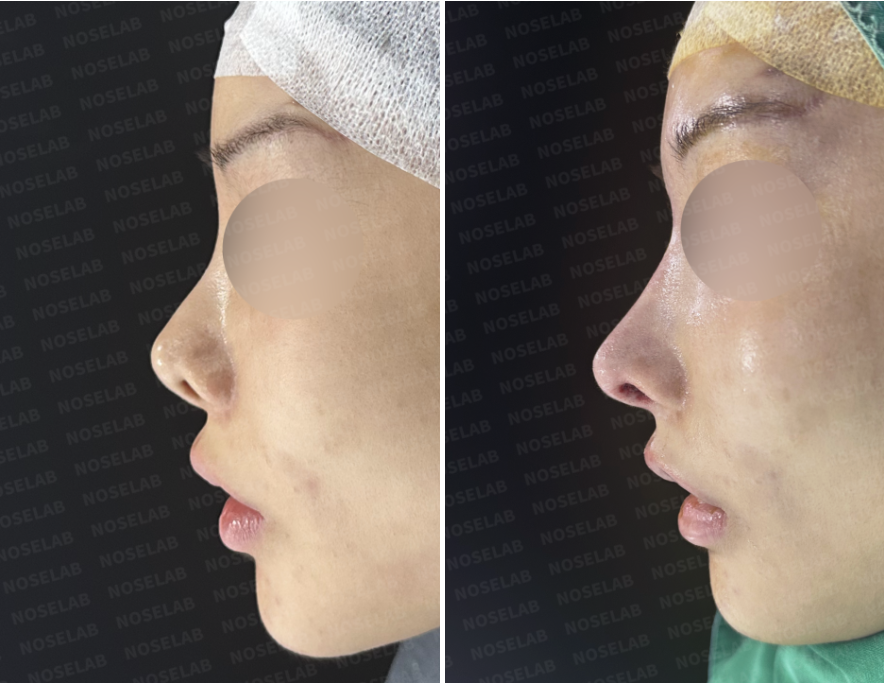Nose Lab Clinic | Closed Rhinoplasty in Korea – Intranasal Mass Removal Case
- noselab
- 7월 3일
- 4분 분량
최종 수정일: 9월 24일
##Closed Rhinoplasty in Korea : A Complex Nasal Mass Removal Case
Hello, this is Dr. Cha-Young Kang, Medical Director at Nose Lab Clinic.
Today, I am sharing a remarkable case of a patient who had been told by multiple hospitals that surgery was not possible due to a persistent nasal mass. We successfully performed complete removal and achieved a safe, stable recovery.
## Surgical History : Multiple Failed Surgeries Before Closed Rhinoplasty in Korea
📍 Surgical History

1st Surgery (2020)
OsteoPore, G-Mesh insertion → Resulted in deformation

2nd Surgery (2021)
OsteoPore, G-Mesh removal
Auricular cartilage graft → Contracture developed


3rd Surgery (2022)
Auricular cartilage graft → Deformation

4th Surgery (2023)
Dermal-fat graft (from lower abdomen)
Development of mass in the left nostril


5th Surgery (2024)
Laser treatment attempted
Mass continued to grow


## Initial Assessment Before Closed Rhinoplasty in Korea
🔎 Initial Assessment

Patient Profile
27-year-old female
Previously advised by other hospitals that surgery was not possible
Primary Concerns
Intranasal mass obstructing the left nostril
Progressive enlargement over several years
Potential malignancy suspected
Severe nasal obstruction
External Hospital Opinions
Surgery deemed too risky
Recommended observation only
Special Considerations
Need to rule out malignancy
Histopathological confirmation essential
Complete excision critical to prevent recurrence
## Patient's Goals for Closed Rhinoplasty in Korea
✨ Patient Goals
Complete mass removal
Prevent recurrence
Safe surgical outcome
## Surgical Process of Closed Rhinoplasty in Korea
💉 Surgical Details (November 26, 2024)
Complete Mass Removal
Precise excision of the obstructing intranasal mass
Preservation of surrounding healthy tissue
Clean resection margins ensured
Histopathological Examination
Detailed pathological analysis for malignancy exclusion
Collaboration with pathology department for expedited results
Foreign Body Removal
Complete removal of residual implants from prior surgeries
Elimination of all inflammation-inducing materials
Ensured a clean surgical environment
Nasal Tip Cartilage Refinement
Structural reinforcement of the nasal tip
Reconstruction to prevent recurrence
Restoration of natural nasal contour
Stem Cell Therapy
Promoted tissue regeneration of damaged areas
Minimized postoperative inflammation
Supported accelerated healing
## Surgical Outcomes After Closed Rhinoplasty in Korea
✅ Surgical Outcomes
Histopathology Results
Confirmed chronic inflammatory tissue
Malignancy conclusively ruled out
Provided significant relief to the patient and family

Successful Mass Removal
Clean and complete excision
Restored normal nasal shape
Marked improvement in nasal airflow

Stable Recovery without Recurrence
No signs of recurrence to date
Smooth, stable healing process
Healthy tissue regeneration confirmed

Surgical Success
Successfully performed surgery deemed impossible elsewhere
Achieved complete mass removal
High patient satisfaction

## Specialist's Commentary on Closed Rhinoplasty in Korea
👨⚕️ Specialist’s Commentary


This was a particularly meaningful case, as the patient had been turned away by multiple hospitals due to the high surgical risk. The mass had been gradually enlarging over several years, raising concerns about potential malignancy.
The priority was obtaining an accurate diagnosis. Given the progressive nature of the mass, malignancy could not be excluded until complete excision and thorough pathology were performed. Fortunately, histopathology confirmed that the mass was chronic inflammatory tissue, not a tumor, providing immense relief for the patient and her family.
The reason other hospitals declined surgery was the complexity of the case: the mass’s location, its size, and tissue damage from repeated prior surgeries made the procedure extremely challenging. In such confined anatomical spaces, achieving complete excision while preserving surrounding healthy tissue requires highly advanced surgical expertise.
The chronic inflammatory mass likely developed as a result of prior implants and prolonged inflammatory responses. The patient’s surgical history indicated that the mass began forming after a dermal-fat graft in 2023, suggesting a chronic foreign body reaction as the primary cause.
The key to surgical success was complete, meticulous removal of the mass. Any residual tissue could have led to recurrence, so we approached the procedure with utmost precision, ensuring no trace remained while protecting healthy nasal structures.
Incorporating stem cell therapy was also a critical decision, as it accelerated healing and minimized inflammatory complications, particularly important in complex revision cases with prior scarring.
To date, the patient has experienced stable healing with no recurrence. Nasal airflow has normalized, and the nostril’s shape has been successfully restored.
This case is a meaningful example that demonstrates even surgeries deemed impossible by other hospitals can achieve excellent outcomes with accurate diagnosis, meticulous surgical planning, and advanced techniques.
A secondary surgery for aesthetic enhancement without implants is planned for April 2025, aiming to further refine the nasal shape while maintaining the current stable condition.
Thank you.Dr. Cha-Young KangMedical Director, Nose Lab Clinic
#ClosedNoseJob #RevisionRhinoplasty #NasalMassRemoval #SafeNoseSurgery #ChronicInflammation #InoperableNoseCases #RhinoplastySpecialist #TumorDifferentialDiagnosis #NoseLabClinic #DrChaYoungKang

Messenger(WhatsApp) : +82 1057360302
Home page : www.noselab.co.kr
Instagram : noselab_global
YouTube : Noselab
Email : noselab@naver.com



댓글